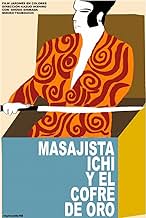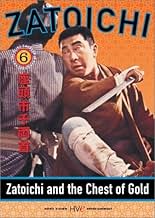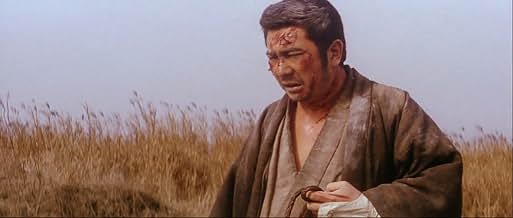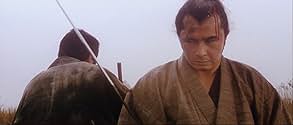VALUTAZIONE IMDb
7,3/10
1945
LA TUA VALUTAZIONE
Aggiungi una trama nella tua linguaZatoichi is mistaken for a thief. To clear his name he must find and defeat the real villain.Zatoichi is mistaken for a thief. To clear his name he must find and defeat the real villain.Zatoichi is mistaken for a thief. To clear his name he must find and defeat the real villain.
- Regia
- Sceneggiatura
- Star
Tomisaburô Wakayama
- Jûshirô
- (as Jo Kenzaburo)
Kenjirô Uemura
- Gundayu Matsui
- (non citato nei titoli originali)
Recensioni in evidenza
This one has my favourite intro of the Zatoichi series. It's incredibly stylish with Ichi slaying numerous groups of hostile samurai in the darkness. The way this chapter of Ichi's saga is told was indeed a welcome change to the visuals and storyboarding, which I felt had stagnated in the previous two films. The plot resonates deeply too. Corruption is the theme of this tale, and of course our hero has to sort this mess out by unleashing some calculated chaos upon the twisted fiends in authority. It would be great if things worked like that in the real world. Maybe if each of us were a little more like Ichi, then one day... who knows.
The following review is an extract from the book "Shintaro Katsu´s Zatoichi: Complete guide to all movies", which is now available on Amazon.
"This is the sixth part of a saga of films shot in the 1960s about the adventures of the blind swordsman Zatoichi. Always motivated by deep convictions and a strong sense of honour, on this occasion Ichi must shed light on the robbery committed against humble peasants in order to prove that he had nothing to do with the crime. Two intriguing women, the clever Ogin and the young Chiyo (sister of the warrior who killed Zatoichi the previous year) will try to prevent the blind masseur from fulfilling his laudable purpose.
(...) In "The chest of gold" we have the rare privilege of seeing in the same film the two masters of the chanbara genre: On the one hand Shintaro Katsu as the heroic Zatoichi and on the other his brother Tomisaburo Wakayama (Ogami Itto en Kozure Okami / "Lone Wolf and Cub") as his antagonist the evil ronin Joshiro. Just as in "Zatoichi's Pilgrimage" (also directed by Kazuo Ikehiro) his opponent Tohachi (Isao Yamagata) has as particularity his skill with kyudo (archery), here Joshiro stands out in the use of another weapon or combative technique: the whip."
"This is the sixth part of a saga of films shot in the 1960s about the adventures of the blind swordsman Zatoichi. Always motivated by deep convictions and a strong sense of honour, on this occasion Ichi must shed light on the robbery committed against humble peasants in order to prove that he had nothing to do with the crime. Two intriguing women, the clever Ogin and the young Chiyo (sister of the warrior who killed Zatoichi the previous year) will try to prevent the blind masseur from fulfilling his laudable purpose.
(...) In "The chest of gold" we have the rare privilege of seeing in the same film the two masters of the chanbara genre: On the one hand Shintaro Katsu as the heroic Zatoichi and on the other his brother Tomisaburo Wakayama (Ogami Itto en Kozure Okami / "Lone Wolf and Cub") as his antagonist the evil ronin Joshiro. Just as in "Zatoichi's Pilgrimage" (also directed by Kazuo Ikehiro) his opponent Tohachi (Isao Yamagata) has as particularity his skill with kyudo (archery), here Joshiro stands out in the use of another weapon or combative technique: the whip."
Zatoichi and the Chest of Gold is one of the most exciting - and exasperating - installments in the series.
The plot is rich in incident and characters. After rural farmers pay their taxes, a corrupt magistrate and his cronies steal the gold, and leave the farmers desperate for a solution. Zatoichi finds himself in the middle of the problem. On one hand, he's pressured by the farmers, who suspect Zatoichi might have participated in the heist...and on the other, the burglary is pinned onto a cadre of honorable yakuza in a secluded hideout.
The story has a few "firsts" for the Zatoichi series. Earlier installments were bloodless, but ZATCOG shows violence for the first time - mostly with a sprinkling of fake blood. It's also the first chance for Zatoichi to develop a truly comic incident - when a smelly, less-than-competent masseuse serves him - then overcharges him.
The most problematic "first" relates to the filmmaking style. Instead of the restrained style of the first few Zatoichi films, ZATCOG uses looser editing and sound than before. Visual edits use slapdash jump cuts that are closer in spirit to the LONE WOLF AND CUB series. Faked visual and sound effects marred less several extended sequences. The most embarrassing sequence has Zatoichi carrying a little boy - clearly a dummy - on his shoulders as he slides down a ridge.
At the least, ZATCOG comes up a bunch of new situations and characters to invigorate the series - even if the director, Kazuo Ikehiro, is less than proficient at this job.
The plot is rich in incident and characters. After rural farmers pay their taxes, a corrupt magistrate and his cronies steal the gold, and leave the farmers desperate for a solution. Zatoichi finds himself in the middle of the problem. On one hand, he's pressured by the farmers, who suspect Zatoichi might have participated in the heist...and on the other, the burglary is pinned onto a cadre of honorable yakuza in a secluded hideout.
The story has a few "firsts" for the Zatoichi series. Earlier installments were bloodless, but ZATCOG shows violence for the first time - mostly with a sprinkling of fake blood. It's also the first chance for Zatoichi to develop a truly comic incident - when a smelly, less-than-competent masseuse serves him - then overcharges him.
The most problematic "first" relates to the filmmaking style. Instead of the restrained style of the first few Zatoichi films, ZATCOG uses looser editing and sound than before. Visual edits use slapdash jump cuts that are closer in spirit to the LONE WOLF AND CUB series. Faked visual and sound effects marred less several extended sequences. The most embarrassing sequence has Zatoichi carrying a little boy - clearly a dummy - on his shoulders as he slides down a ridge.
At the least, ZATCOG comes up a bunch of new situations and characters to invigorate the series - even if the director, Kazuo Ikehiro, is less than proficient at this job.
I had low expectations for this film but have to say it was a pleasant surprise. The story had humor, visually it was very interesting, and at times beautiful. The lead actor is very good and I'd like to see more of his work.
10inframan
I think this stunning film ranks among the great action films of all time but could be hung as stills in any art museum. Hokusai & Hiroshige influences abound.
Yet best of all is the unforgettable character Zatoichi himself. Shintaro Katsu created an everyman/superhero who had no equal, at least in western culture. A squat, homely, bandy-legged self-deprecating blind man full of humor & humility & an abundance of spirituality. And could he make that sword dance.
These movies have no equal. Each one is as perfectly made as any movie can be. I used to go see them when they first appeared in the theaters of San Francisco & Los Angeles Japanese neighborhoods. I still love them every bit as much now.
Yet best of all is the unforgettable character Zatoichi himself. Shintaro Katsu created an everyman/superhero who had no equal, at least in western culture. A squat, homely, bandy-legged self-deprecating blind man full of humor & humility & an abundance of spirituality. And could he make that sword dance.
These movies have no equal. Each one is as perfectly made as any movie can be. I used to go see them when they first appeared in the theaters of San Francisco & Los Angeles Japanese neighborhoods. I still love them every bit as much now.
Lo sapevi?
- QuizJushiro is played by Shintarô Katsu's real-life brother, Tomisaburô Wakayama, who would later star in the Lone Wolf and Cub series of films (produced by Katsu).
- ConnessioniFeatured in Best in Action: 1964 (2020)
I più visti
Accedi per valutare e creare un elenco di titoli salvati per ottenere consigli personalizzati
- How long is Zatoichi and the Chest of Gold?Powered by Alexa
Dettagli
- Data di uscita
- Paese di origine
- Lingua
- Celebre anche come
- Zatoichi and the Chest of Gold
- Azienda produttrice
- Vedi altri crediti dell’azienda su IMDbPro
- Tempo di esecuzione1 ora 23 minuti
- Proporzioni
- 2.35 : 1
Contribuisci a questa pagina
Suggerisci una modifica o aggiungi i contenuti mancanti

Divario superiore
By what name was Zatôichi senryô-kubi (1964) officially released in India in English?
Rispondi




























